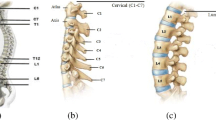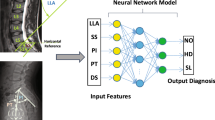Abstract
The present research paper deals with the reconstruction process of thoracic spine images through 2D thoracic spine x-ray images with the help of Artificial Neural Network and Fuzzy Set Rules. The present work has been carried out in two phases: the Modelling phase and Understanding phase. In the modeling phase, a knowledge-based model has been framed with natural human anatomy spine images collected from different sources. The formation of model has been done after proper selection and extraction of geometric features from natural human anatomy images. The features are based on shape size orientation. In the present paper the main focus has been kept on the extraction of twenty features based on the different orientation of thoracic spine image. A unique innovative approach for feature selection, extraction and mapping are adopted in the present paper for understanding the model, for proper reconstruction of 3D thoracic spine images through thoracic spine X-ray/MRI/CT images. The mapping and classification process has been done using Support Vector Machine. The experimental work has been carried out using Artificial Neural Network and Fuzzy Set Rules.
Access this chapter
Tax calculation will be finalised at checkout
Purchases are for personal use only
Similar content being viewed by others
References
Gonzalez, R.C., Woods, R.E.: Digital Image Processing, 3rd edn. Pearson Education, London (2013)
Jain, A.K.: Fundamentals of Digital Image Processing. Pearson Education, London (2013)
Long, L.R., Thoma, G.R.: Computer assisted retrieval of biomedical image features from spine x-rays: progress and prospects. Open access. http://archive.nlm.nih.gov/staff/long.php
Wang, S., Summers, R.M.: Machine learning and radiology. Medical Image Analysis 16, 933–951 (2012)
Major, D., Hladucvka, J., Schulze, F., Bühler, K.: Automated landmarking and labeling of fully and partially scanned spinal columns in CT images. Med. Image Anal. 17, 1151–1163 (2013)
Wade, R., Yang, H., McKenna, C., Faria, R., Gummerson, N., WoolacottL, N.: A systematic review of the clinical effectiveness of EOS 2D/3D X-ray imaging system. Euro Spine J. 22, 296–304 (2013)
Yvanl, P., Jean, D., Hubert, L., de Guise, J.: 3D radiographic reconstruction of thoracic facet joints. In: The Proceeding of IEEE-EMBC and CMBEC, vol. 2, pp. 397–408 (2005)
Lin, H.: The simplified spine modeling by 3-D Bezier curve based on the orthogonal spinal radiographic images. In: The Proceeding of the 25th Annual International Conference of the IEEE EMBS, pp. 945–946 (2006)
Delorme, S., Petit, Y., de Guise, J.A., Labelle, H., Aubin, C.-É., Dansereau, J.: Assessment of the 3-D reconstruction and high-resolution geometrical modeling of the human skeletal trunk from 2-D radiographic images. IEEE Trans. Biomed. Eng. 50(8), 989–998 (2003)
Novosad, J., Cheriet, F., Petit, Y., Labelle, H.: Three-dimensional (3-D) reconstruction of spine from a single x-ray image and prior vertebra models. IEEE Trans. Biomed. Eng. 51(9), 1628–1639 (2004)
Lin, H.: Identification of spinal deformity classification with total curvature analysis and artificial neural network. In: The proceedings of the 2005 IEEE Engineering in Medicine and Biology 27th Annual Conference, pp. 6168–6171 (2005)
Benjelloun, M., Mahmoudi, S.: Mobility estimation and analysis in medical x-ray images using corners and faces contours detection. In: The Proceeding of International Machine Vision and Image Processing Conference, pp. 106–115 (2007)
Zhang, Y., Wang, M., Song, Z.: Multi-step 3D/2D image registration for image-guided spinal surgery. In: The Proceeding of International Conference on BioMedical Engineering and Informatics, pp. 188–192 (2008)
Boisvert, J., Cheriet, F., Pennec, X., Labelle, H., Ayache, N.: Articulated spine models for 3-D reconstruction from partial radiographic data. IEEE Trans. Biomed. Eng. 55(11), 2565–2574 (2008)
Kadoury, S., Cheriet, F., Labelle, H.: Segmentation of scoliotic spine silhouettes from enhanced biplanar x-rays using prior knowledge bayesian framework. In: The Proceeding of ISBI, pp. 478–481 (2009)
Yang, H., Yu, B., Wang, A.: Measurement of cross-sectional area of spinal canal through coordinate axis rotation and projection transformation. In: The Proceeding of Second International Symposium on Knowledge Acquisition and Modeling, pp. 95–97 (2009)
Kadoury, S., Cheriet, F., Labelle, H.: Personalized x-ray 3-D reconstruction of the scoliotic spine from hybrid statistical and image-based models. IEEE Trans. Med. Imaging 28(9), 1422–1435 (2009)
Qian, X., Tagare, H.D., Fulbright, R.K., Long, R., Antani, S.: Optimal embedding for shape indexing in medical image databases. Med. Image Anal. 14, 243–254 (2010)
Punarselvam, E. Suresh, P.: Edge detection of CT scan spine disc image using canny edge detection algorithm based on magnitude and edge length. In: The Proceeding of IEEE, vol.1, pp. 136–140 (2011)
Kadoury, S., Labelle, H., Paragios, N.: Automatic inference of articulated spine models in CT images using high-order Markov random fields. Med. Image Anal. 14, 426–437 (2011)
Anitha, H., Prabhu, G.K.: Automatic quantification of spinal curvature in scoliotic radiograph using image processing. J. Med. Syst. 36, 1943–1951 (2012)
Larhmam, M.A., Mahmoudi, S., Benjelloun, M.: Semi-automatic detection of cervical vertebrae in x-ray images using generalized hough transform. In: The Proceeding of Image Processing Theory, Tools and Applications (2012)
Wu, C.-C., Li, H.-C., Chiang, Y.-H., Lin, J.: Classification of cross-section area of spinal canal on kernel-based support vector machine. In: The Proceeding of IEEE International Conference on Systems, Man, and Cybernetics, pp. 2622–2625 (2012)
Zhang, J., et al.: 3-D reconstruction of the spine from biplanar radiographs based on contour matching using the hough transform. IEEE Trans. Biomed. 60(7), 1954–1964 (2013)
Cortez, S., Claro, J.C.P., Alves, J.L.: 3D reconstruction of a spinal motion segment from 2D medical images: objective quantification of the geometric accuracy of the FE mesh generation procedure. In: The Proceeding of 3rd Portuguese Meeting in Bioengineering (2013)
Boev, A., Bregovic, R., Damyanov, D., Gotchev, A.: Anti-aliasing filtering of 2D images for multi-view auto-stereoscopic displays. In: The Proceeding of IEEE, vol. 5, pp. 87–97 (2009)
Do, C.M., Javid, B.: 3D integral imaging reconstruction of occluded objects using independent component analysis-based K-means clustering. J. Display Technol. 7(6), 251–262 (2010)
Author information
Authors and Affiliations
Corresponding author
Editor information
Editors and Affiliations
Rights and permissions
Copyright information
© 2019 Springer Nature Singapore Pte Ltd.
About this paper
Cite this paper
Agrawal, S., Sisodia, D.S., Nagwani, N.K. (2019). Neuro-Fuzzy Approach for Reconstruction of 3-D Spine Model Using 2-D Spine Images and Human Anatomy. In: Prateek, M., Sharma, D., Tiwari, R., Sharma, R., Kumar, K., Kumar, N. (eds) Next Generation Computing Technologies on Computational Intelligence. NGCT 2018. Communications in Computer and Information Science, vol 922. Springer, Singapore. https://doi.org/10.1007/978-981-15-1718-1_9
Download citation
DOI: https://doi.org/10.1007/978-981-15-1718-1_9
Published:
Publisher Name: Springer, Singapore
Print ISBN: 978-981-15-1717-4
Online ISBN: 978-981-15-1718-1
eBook Packages: Computer ScienceComputer Science (R0)




